Text
Mini Review: Full Contact (1993)
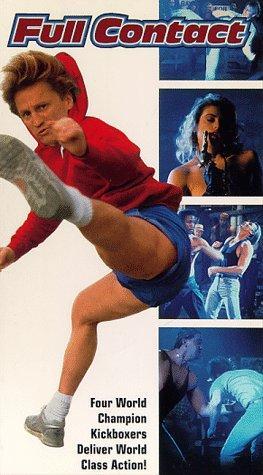
SOURCE
Full Contact is the revisiting of a martial arts revenge story filmed some four years prior – Bloodfist. The remake sees the setting move from Manila to Los Angeles, and Don Wilson replaced by fellow kickboxer Jerry Trimble. Considering it’s a noticeably less ambitious picture, Full Contact holds up surprisingly well.
The story: A martial artist (Trimble) arrives in the city to find that his brother’s been murdered while participating in an underground fight circuit. Under the tutelage of an unconventional trainer (Marcus Aurelius), he prepares to enter the fights to uncover the killer’s identity.
Director Rick Jacobson was, at the time, busying himself with mostly run-of-the-mill action features, so it’s surprising how much he ends up getting out of this. With the help of engaging camerawork and a script that firmly establishes its characters before dropping them into the heat of action, the filmmakers get the most out of their limited resources. Despite the presence of some bad acting (that’s nevertheless counterbalanced by some decent chemistry between Trimble and Aurelius), it feels more like a genuine movie than many other video releases – not to be mistaken for a theatrical feature, but it could definitely be aired on some channel other than SyFy,
Surprisingly, the action content ends up being a minor disappointment. It’s not that the ample fighting is bad – Trimble’s fights are always highlights, thanks to the star’s excellent kicks – but despite having no less than three choreographers working on them, the fights tend to meld together, with not nearly enough variance in fighting styles or combatants’ personalities. The story’s strong enough that this doesn’t kill the film, despite its genre, but it’s ironic that the time I should choose to browse my phone during a karate movie is during the karate scenes.
This one’s not worth buying a VCR for, but if you already own one, give Full Contact a look – especially if you’ve been impressed by Trimble in other movies.

Full Contact (1993)
Directed by Rick Jacobson (Ring of Fire III: Lion Strike)
Written by Robert King (based on a story by), Beverly Gray (Fire on the Amazon)
Starring Jerry Trimble (The Master), Marcus Aurelius (Kung Fu Brother), Denise Buick (Angelfist), Raymond Storti (Amazon Warrior)
Cool costars: Pro fighters Howard Jackson, Alvin Prouder, Gerry Blanck, Joe Charles, Dino Homsey, Hyon Lee, Dennis Keiffer, and Jeff Podgurski all appear as onscreen combatants, as do Hiro Koda, Michele and Jamie Krasnoo, Mark Zacharatos, and Rae Manzon.
Content warning: Sexual assault, violence against women, homophobic dialogue
Title refers to: A set of rules in combat sports that allows you to strike your opponent as hard as you want but not wherever you want. Sort of a misleading name, since the fights in the film have no restrictions.
Cover accuracy: The vertical stills do indeed occur. Oddly, while Jerry Trimble rocks the terrible combination of a hoodie and short-shorts, his hoodie in the movie is gray.
Number of full-length fight scenes: 15
Copyright Califilm
#film review#film criticism#martial arts#martial arts film#jerry trimble#marcus aurelius#denise buick#raymond storti#rick jacobson#beverly gray#kickboxing#karate
17 notes
·
View notes
Text
Oh wow.
First of all, sorry for taking so very long to notice your reblog. Went right under my radar.
Second of all, you’re right. I got that wrong. I don’t think Kim’s IMDb page was quite as detailed at the time as it is now, but nevertheless, I need to be sure to double-check details on people I don’t know that well.
And lastly, thank you for taking the time to read my review and alert me. I’m going to either edit the original post or add an erratum note.
Review: Ballistic (1995)
“Touch that gun, I’ll shove it up your ass and pull the trigger!”
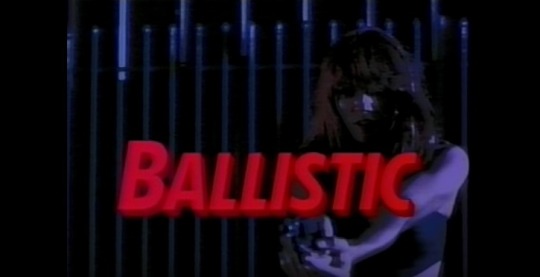
Even 23 years after its release, Ballistic is a breath of fresh air. I put off buying it for a long time because of the higher-than-average price tag it goes with these days, but that was a mistake; it’s worth every penny. This isn’t the perfect action movie and it isn’t quite unique enough to be in a class of its own, but it gets enough of the genre’s necessities right while also adding some extra touches to make for a genuinely worthy video entry. Putting its assets to good use while avoiding any glaring faults, this is a great vehicle for first-time star Marjean Holden and a real hidden gem in the VHS mine.
The story: When a straight-shooting detective (Holden) is falsely implicated in a murder, she must prove a conspiracy between the department and a sleazy arms dealer (Sam Jones).
Marjean Holden is a fixture of the U.S. action scene, but despite her career spanning theatrical, video, and TV work, she’s been underutilized as a martial arts star. She’s best known for her exotic but disappointing role in Mortal Kombat: Annihilation (1997), and to date, Ballistic is the only action picture she stars in. There’s no apparent reason why she’s seen so little lead roles, as Holden uses the opportunity to prove herself the complete package. She has an engaging screen presence and more than one note to her acting. Her martial arts lack the world-class sheen of a Cynthia Rothrock but she’s yards better than, say, Mimi Lesseos. Or Michael Dudikoff. In a perfect world, Ballistic would be the rough freshman effort that helps lead to a polished solo career. As is, it’s a good demonstration of how to build up a potential star, especially when you have plenty of other assets at hand.
The production values are what you’d expect from an upper-level DTV studio like Imperial, and the cast is surprisingly great for this kind of film. Sam Jones is an appropriately smug villain, and Charles Napier brings some dramatic clout to the ensemble. Cult hero Richard Roundtree plays Holden’s onscreen father, and while I’ve grown to regard Roundtree as someone who gets top billing and then only appears in a handful of scenes, he’s a genuine character here and is made full use of as an action veteran. And amid a fair number of recognizable enforcers and onscreen combatants, the great star-to-be Michael Jai White shows off his moves as he does in few films that he’s not actually starring in. Everyone plays to their strengths, whether that be martial moves or dramatic prowess. While nobody was about to win awards for this film, no one’s phoning it in, either.
The things that set this movie apart are Holden’s relationships to some of the other supporting figures – specifically Richard Roundtree and her onscreen boyfriend Joel Beeson (The Dragon Ring). You can guess that martial artist Beeson will make his way into the greater story, but it’s not until the film’s second half when Roundtree’s character is released from prison and joins in the plot that both assume prominence almost equal to Holden. In a lesser movie, this might give the impression of the filmmakers not having confidence in their star’s potential to headline, but surprisingly good writing conveys the importance of family in this scheme. Thematically, Holden’s family – defined by their entertaining, well-established interrelationships – proves itself stronger than the shifty criminal enterprise. It’s probably not what the 18-36 male demographic was demanding, but the film’s all the better for it.
The fight content is a mixed bag, but even here there are definite high points. Again, Michael Jai White is fantastic, even if he can’t always find opponents to match his acrobatic skills. Joel Beeson is a pretty decent kickboxer; in any other incarnation of this film, he’d be the lead. And while Marjean Holden may technically be the least skilled performer to have more than one fight, she proves versatile in a weapons-based match and has a fun climactic brawl against Corinna Everson – the bodybuilder from Double Impact who you’ll subsequently agree was severely underutilized in her fight with Jean-Claude Van Damme.
All of this plays out under the direction of Kim Bass. Bass is one of the very few women who’ve directed a martial arts film in the U.S., and while her aesthetic approach is virtually indistinguishable to my eye, she’s got a sense for action and deserves much credit for everything she gets out of her main characters. I can’t think of many directors who’d produce the same familial kinship in a picture while also filming skillful karate encounters, and in light of that, it’s a shame that Bass has yet to direct another martial arts feature. On the other hand, that just makes Ballistic stand out all the more. I like this movie a lot, and the fact that there are few others like it makes it a little precious. There’s a good chance others will like it, too, so give it a look if you happen to find it on TV or in a thrift shop.

Ballistic (1995)
Directed by Kim Bass (Kill Speed)
Written by Don Lamoreaux (creative consultant for Day of Days)
Starring Marjean Holden, Joel Beeson, Richard Roundtree (Shaft trilogy), Sam Jones (Flash Gordon)
Cool costars: Charles Napier (The Silence of the Lambs), Corinna Everson, James Lew (Balance of Power), Julie St. Claire (A.J.’s Time Travelers), Michael Jai White (Blood and Bone), Vincent Klyn (Cyborg), Robert Miano (Broken Blood), Nils Allen Stewart (Mercenary), Georges Bejue (Cage II)
Content warning: Sexist dialogue
Copyright Imperial Entertainment Corp.
10 notes
·
View notes
Text
Dragon Profiles: STEFANOS MILTSAKAKIS (1959-2019)
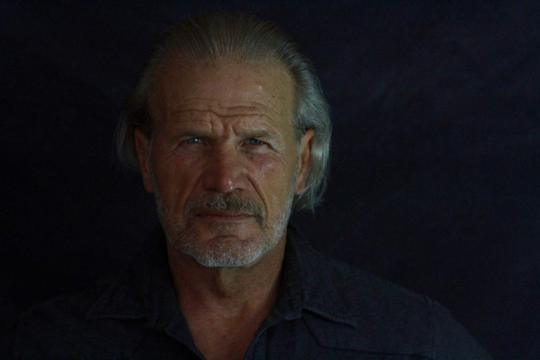
When the definitive contest to determine the best b-movie villain takes place, we won’t be able to begin considering a winner without a nod to Stefanos Miltsakakis – almost certainly the most intimidating baddie that karate videos ever offered. A genuine badass who had the luck of being well-utilized in a film career spanning TV, video, and theatrical incarnations, Miltsakakis made his mark in the martial arts subgenre and helped ease the scene towards the MMA influence we now see everywhere.
A tough childhood as an immigrant set Stefanos on the path of combat sports at a young age, and he learned wrestling and the ancient art of pankration long before attaining cinematic fame. He earned a place on the Greek national wrestling team and later expanded to professional competition, headlining the 9th and 14th World Vale Tudo Championships. He boasted a perfect fight record and, according to some sources, was awarded the WVC Championship twice. This was a fighter who could easily back up his film reputation, which was forever cemented as an indomitable enforcer in several of Jean-Claude Van Damme’s blockbusters.
Tragically, Stefanos died in his sleep in the second week of January, aged 59-60 – possibly the end of his struggle with heart problems. Though the martial arts fandom rightfully mourns the loss of one of its most talented stars, we should also appreciate and celebrate the legacy he’s left behind. Check out his most famous appearances in films like Maximum Impact, but don’t neglect his equally thrilling performances in video productions.
Styles & Accomplishments
Vale Tudo / Mixed Martial Arts (record: 3-0)
Brazilian Jiu-Jitsu
Pankration
Films to See
Bloodsport: The Dark Kumite (1999) – co-lead / co-fight choreographer
Martial Outlaw (1993) – supporting role
Derailed (2002) – supporting role
Trivia: Miltsakakis was set to represent Greece in the 1984 Summer Olympics, but a knee injury forced him to withdraw shortly before the event.
Video
Film clips, training, and fighting
3 notes
·
View notes
Text
Mini Review: Dragon Fire (1993)
“Shit! Are you fighting or dancing?”
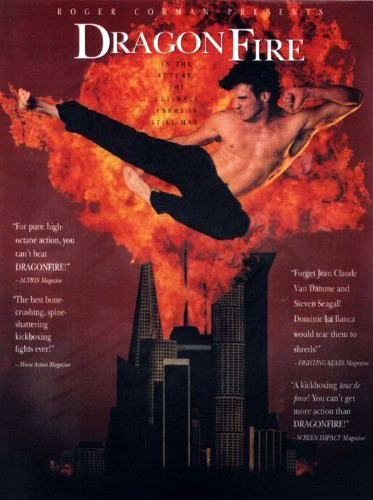
SOURCE
Another Roger Corman-produced martial arts flick, another review. In short, Dragon Fire is pretty decent.
The story: Off-world martial artist Laker Powers (Dominick LaBanca) arrives on a dingy futuristic Earth to find out that his brother has been murdered following participation in a deadly street fighting circuit. With the aid of a streetwise trainer (Kisu), he enters the fights to uncover the killer.
Much credit goes to Dominick, who’s definitely one of the more complete karate guys to not have had much of a starring career. The film very much plays to his strengths, taking the strain off his dramatic requirements via score and cinematography while still highlighting his natural charisma. He’s in good company with best buddy Harold Hazeldine, a lovable kung fu dork, but that’s about the end of positive things I have to say about the acting, as love interest Pamela Pond and trainer Kisu will particularly test your ability to keep from laughing. Of course, none of them are dealing with a fantastic script – expect a good deal of convolution and using the action scenes as a crutch – but that’s not to say it isn’t solid or doesn’t create a world where thematic shortcomings break the picture.
For a movie that chose to set its story in a sci-fi world, it’s not very ambitious. The neon-tinged art direction is kind of cool, but the setting isn’t integral to the story and may have been decided on because the studio wanted a sci-fi flick and had stock footage from Battle Beyond the Stars to use. Of course, as this ultimately is a martial arts exploitation film seeking to showcase as many fight scenes as it can, there’s no reason to be picky. After all, the fight scenes tend to be good. For sure, there are some bad matches and some of the performers aren’t utilized particularly well (I’m sorry, Rod Kei), but overall the fights are a smorgasbord of diverse combatants with mildly unique fighting styles. You’re sure to find at least some you’ll enjoy.
If Dominick LaBanca hadn’t turned into a homophobic religious nut, I’d be disappointed that this is the only movie he starred in, ‘cause Dragon Fire proves that the guy had the right stuff to be a regular of the karate video scene. The movie’s worth a watch if you’re not only interested in Hong Kong-style fight scenes, so check it out!

SOURCE
Dragon Fire (1993)
Directed by Rick Jacobson (Ring of Fire 3: Lion Strike)
Written by Robert King (based on a story by), Beverly Gray (Fire on the Amazon), Kevin Ingram
Starring Dominick LaBanca (Street Survival), Kisu (Shootfighter), Pamela Pond (Sins of Desire), Harold Hazeldine (Out for Blood)
Cool costars: The impressive list of fighters includes Michael Blanks (Expect No Mercy), Dennis Keiffer (Mortal Kombat: Annihilation), Randall Ideishi (Black Scorpion), Rae Manzon (Firepower), Carolyn Raimondi (Bloodfist IV), Jonas Johannes (High Kicks), Rod Kei (Full Impact), Greg Duimovich (To Be the Best), karate master Val Mijailovic, and taekwondo stars James Choi and Hyung Lee. B-movie boss Monique Parent (Jack Vs. Lanterns) appears as a dancer. Aaron Osborne, who cameos as a doctor, would later win a Primetime Emmy for art direction on Without a Trace.
Cool crew: Editor John Gilbert later won a Daytime Emmy for his work on V.I.P.
Content warning: Sexual assault, flashing imagery
Title refers to:
Cover accuracy: I’m pretty sure Dominick LaBanca throws a flying kick similar to that in the movie, but the red and orange background doesn’t match the film’s color palette at all and we never see any skyscrapers.
Number of full-length fight scenes: 18
Copyright Pacific Trust / New Concorde
#film review#film criticism#dragon fire#rick jacobson#dominick labanca#harold hazeldine#kisu#pamela pond#martial arts#martial arts film#sci-fi
2 notes
·
View notes
Text
Mini Review: Bloodfist (1989)
“Goddamn it! Save it for the ring!”

SOURCE
I don’t know if anyone predicted in 1989 that Don Wilson – the most decorated kickboxer of his time – would become the most successful karate video star of all time. Nevertheless, Bloodfist is a pretty good springboard, featuring a lively cast, solid production values, and no shortage of fight scenes. Even if you’re not a Wilson fan, this one’s required viewing for devotees of the subgenre.
The story: When his half-brother is murdered following participation in a vicious martial arts tournament, boxer Jake Raye (Wilson) travels to Manila to unmask the killer.
Even as he’s just embarking on his solo career, Wilson comes to us more or less fully cooked, charisma and action style already in place. You can’t tell this is his first time in the spotlight, and he’s surrounded by players who know their stuff as well. Michael Shaner’s pretty likable as the comic relief, as is Riley Bowman (despite not having much to do once she becomes a love interest), and Joe Mari Avellana exudes presence and gravity as Wilson’s trainer. The plot’s nothing special, but it’s solid in its simplicity. I wish they’d done more with the emotional aspects in the characters’ relationships, though.
The action content is exclusively martial arts-related, and while the quality of the fights frequently dips via undercranking and performers uncomfortable with the choreography, it’s generally passable. It makes for some gravitas that all of Wilson’s major opponents are given appropriate introductions and backgrounds, and the matches between him and Billy Blanks and Cris Aguilar are pretty memorable. Wilson himself will never be mistaken for Jet Li when it comes to being a flashy onscreen combatant, but even he looks awesome in his training montage.
Bloodfist is also one of the more lavish and artful productions starring Don Wilson, taking its time to showcase wide cinematography, establish colorful locales, and have fun with its art direction, camerawork, and editing. I’m not sure what director Terence H. Winkless thinks of when he looks back on his 40+ year career, but I hope he’s proud of what sound work he did here. For certain, check it out at least once.

SOURCE
Bloodfist (1989) [also known as Bloodfist Fighter]
Directed by Terence H. Winkless (Rage and Honor)
Written by Robert King (Cutthroat Island)
Starring Don Wilson (Ring of Fire series), Joe Mari Avellana (Field of Fire), Riley Bowman (Stolen Kisses), Michael Shaner (The Expert)
Cool costars: Cris Aguilar (Death Cage), Rob Kaman (Maximum Risk), Billy Blanks (The King of the Kickboxers), Ned Hourani (Triple Threat), and Greg Rocero (Live by the Fist) all appear as fighters, as does stunt coordinator / action guru Ronald Asinas. Good old Vic Diaz (Blackbelt II) appears as a nasty police chief, and Marilyn Bautista (The Big Boss) has an utterly thankless role as Michael Shaner’s slavish girlfriend.
Cool crew: Cinematographer Ricardo Jacques Gale would later win awards for his work on movies like West Beirut. Post-production director Chantal Feghali, who’d also become a producer and visual effects consultant, would eventually work on major motion pictures like The Hunger Games and Terminator: Salvation.
Content warning: Sexual assault, violence towards women, homophobic dialogue
Title refers to: There’s literally a scene where Don Wilson holds up his fist and it’s drenched with blood. Additionally, even though Wilson probably wouldn’t admit it, it could be a nod to Jean-Claude Van Damme’s Bloodsport.
Cover accuracy: Wilson and Billy Blanks do indeed through simultaneous flying kicks. However, Blanks’ hairstyle seems to have changed between cover and production, and I don’t recall him wearing those pants at any point. Also, there’s no reason other than marketing to give him top billing.
Number of full-length fight scenes: 19
Copyright New Horizons
#martial arts#martial arts film#bloodfist#terence h. winkless#don wilson#joe mari avellana#riley bowman#michael shaner#kickboxing#film criticism
3 notes
·
View notes
Text
Mini Review: Bloodfist 2050 (2005)
*SPOILERS AHEAD*

SOURCE
Bloodfist 2050 is the final installment in the Bloodfist series, the last movie by director Cirio Santiago released before his death, and his final collaboration with U.S. counterpart Roger Corman. It’s a callback to martial arts exploitation flicks of yesteryear, released during a general dearth of karate flicks, and even now remains one of the movies most rich in fight scenes. However, it’s not particularly ambitious and has very evident shortcomings, so it’s best viewed in context.
The story: In a post-apocalyptic future Los Angeles, a young fighter (Matt Mullins) learns that his brother was murdered while participating in a lethal fighting circuit. With the aid of a cynical detective (Joe Sabatino), he enters the fights to uncover the killer.
Though my long-term hopes for him as an action hero were ultimately disappointed, baby-faced Matt Mullins is easily the best thing about the movie. This is the single most liberal display of his talents as an acrobatic fighter, and his matches are all highlights. The remaining 15 or so usually aren’t as good, featuring slow and stilted choreography. Few of the combatants are worth watching for, and as the action content’s almost entirely fight-oriented, it means that the movie largely fails in this regard.
The screenplay is troublesome. The story is simple and straightforward, but the world it takes place in is so rife for developing that not doing so feels lazy. There’s so much possibility for social commentary – police militarization and a water shortage so severe that human corpses are recycled for their moisture, etc. – but the movie’s decision to not examine any of it seems indolent. This especially feels so when it chooses to instead fill up its runtime with striptease and sex scenes. Some ten minutes of this 78-minute flick is made up of these bits. Jeez, straight people – enough is enough!
The movie is technically competent, though there’s a good deal of stock footage and the sets generally look junky. Then there’s the editing, which is jumpy and abrupt and gives the impression that the filmmakers didn’t shoot quite enough footage. Of course, being a Santiago film, this isn’t that big of a surprise or so grand a problem. This is seat-of-the-pants filmmaking, and if the filmmakers’ resources run just a size or two short, well, that’s just the way the dragon breathes.
Every martial arts fan should watch at least a couple of Santiago movies, if only for perspective. Bloodfist 2050 is far from perfect but hardly boring, so I recommend it if only to fill that quota. Check it out if you don’t have to go far out of your way, or catch the TV version and skip all the nude scenes.

SOURCE
Bloodfist 2050 (2005)
Directed by Cirio H. Santiago (Raiders of the Sun)
Written by Rick King (uncredited), Michael Henry Carter (The Hunt for Eagle One series)
Starring Matt Mullins (Death Fighter), Joe Sabatino (Batman & Robin), Beverly Lynne (Tanya X), Glen Meadows (Embrace the Darkness 3)
Cool costars: B-movie staple Joe Mari Avellana plays the MC. His fighters include Monsour Del Rosario (Bloodfist II), James Gregory Paolleli (Beyond the Call of Duty), Chris Brewster (Bunraku), Nash Espinosa (Operation Rogue), and Cris Aguilar (Death Cage).
Cool crew: Popeye co-directed the fight scenes. Yes, you read that correctly.
Content warning: Police brutality
Title refers to: As a remake of the original Bloodfist, it shares the same title. The number 2050 is presumably the year in which the story takes place.
Cover accuracy: Matt Mullins throwing a kick in front of the dystopian-looking city is apt enough, but I have no idea who the other martial artist is. Also, I have no idea who the woman is. That doesn’t look like Beverly Lynne.
Number of full-length fight scenes: 22
Copyright Concorde-New Horizons
#film review#film criticism#martial arts#martial arts film#bloodfist 2050#cirio h. santiago#matt mullins#joe sabatino#beverly lynne#glen meadows
3 notes
·
View notes
Text
Review: Death Match (1994)
“Go ahead, if you and your friends want to look like Swiss cheese”

SOURCE
My opinion regarding kickboxer/actor/activist Ian Jacklin is a little more complicated than with most karate stars, but in a nutshell, I thought the guy was pretty cool until I realized that he spends his life promoting quackery to cancer patients. Nevertheless, I enjoy his acting career and see it as a microcosm of a successful B-movie trajectory, with Death Match being the climax. Created outside of the major video studios, it has an unambitious story but a good production with a huge amount of martial talent. It’s required watching for fans of the subgenre and easily the best of Jacklin’s film career.
The story: An ex-fighter (Jacklin) goes undercover in a deadly fighting circuit to rescue his kidnapped best friend (Nicholas Hill).
I need to emphasize the state of the production, even though it may seem odd to praise a film for looking average. Keep in mind how easy it is for indie movies to turn out like crud. By all rights, Death Match should’ve been interchangeable with a typical Cine Excel production (underpopulated vistas, dubbed dialogue, etc.) but it’s actually indistinguishable from most Pepin-Merhi or Shapiro-Glickenhaus actioneers. As a matter of fact, it would be pretty aspirant for a PM or SG production, given the impressive list of names in the cast. To be fair, we sometimes only get a little taste of them – cult stars Richard Lynch and Jorge Rivero have only one scene apiece as Mafia bosses – but the list of talent goes on. Martin Kove and Matthias Hues are good as the lead villains, with Kove supplying the drama and Hues most of the fighting. Steven Leigh, Eric Lee, and Benny Urquidez don’t have any fights but do well in their dramatic scenes. Michele Krasnoo, Butch Togisala, Randall Ideishi, Ed Neal and Peter Cunningham partake in some of the highlighted brawls, and many more show up elsewhere. If these names aren’t clicking, you haven’t been watching movies like this long enough. The sheer accumulation of performers with reputations in the genre is amazing, especially since your average PM production sometimes wouldn’t even spring for half.
Of course, presence isn’t as important as utilization. The real question is how good the 16 fight scenes are, and the answer is that they’re a mixed bag. On the bright side, there are no downright bad matches and the choreography is nicely varied – some street-fighting, some shoot boxing, and even a lone stick fight. There are some some surprisingly long shots highlighting lengthy exchanges, and a few performers have standout moments of action. (I really enjoyed the Matthias Hues-Dino Homsey bout.) However, for the most part, nobody performs the best work of their career. Michele Krasnoo is made the least of, being introduced as a fighter but then only engaging in half a match. I have the impression that the choreographers were simply stretched too thin by crafting this many fights on a limited schedule. If so, then I wish the number of brawls had been cut in half and the remaining ones given more flair.
Socially, the movie has good points and bad points. Where the latter is concerned, the fact that two women are cast in fighting roles is undermined by the female lead (Renee Allman) abandoning the sparks of characterization to play a formulaic love interest. Additionally, a sexual harasser (played by Bob Wyatt) is inexplicably made a supporting character. However, I like that the movie seems to be championing an anti-capitalist message, using organized crime and fighting as metaphors. The villains trap fighters in a system that depends on their toil while devaluing their lives, and the same villains consider theft against them to be the single greatest crime. Threatening their income by refusing to fight by their rules is likewise punishable. The protagonist sets himself apart from this system by having abandoned organized fighting and claiming to compete solely “for the competition” - not exactly a fair outlook in light of all the pro fighters in real life who earn their income via competition, but it’s nevertheless a repudiation of the metaphorical wage slavery in the feature. Death Match isn’t The Godfather when it comes to allegory, but it’s effective in delivering its message.
There’s a moment in the film when Jacklin’s character is weirded out by Martin Kove’s belief in the supernatural powers of crystals. Retrospectively, it’s funny to see Jacklin in the role of the skeptic (even though crystal power seems to be one of the few areas of nonsense that Ian hasn’t stated a belief in), but I have to admit that he does well enough as the lead. He doesn’t have quite the charisma of, say, Don Wilson, but that’s not to say he wouldn’t have made a good star in the long run. Indeed, I wish he would’ve been handed another top role before the end of the martial arts genre’s video golden age. Nevertheless, his undisputed high point here is worth hunting down if you’re a collector. Death Match encapsulates many of the essentials seen in movies like this and adds just enough of an inspired touch earn a recommendation from me. Check it out wherever you can.

SOURCE
Death Match (1994)
Directed by Joe Coppoletta (The New Adventures of Robin Hood)
Written by Curtis Gleaves (story & screenplay), Bob Wyatt, Steve Tymon (Ring of Fire II: Blood and Steel)
Starring Ian Jacklin (Kickboxer 3), Martin Kove (The Karate Kid), Matthias Hues (Bounty Tracker), Renee Allman (The Stoned Age)
Cool costars: Martial arts regulars Steven Vincent Leigh (Sword of Honor) and Eric Lee (Ring of Fire) appear in acting roles but don’t fight. Similarly, kickboxing hall of famer Benny Urquidez (Wheels on Meals) is limited to a training montage but offers his Jet Center studio as a filming location. Sexy pro wrestler Stevie “Puppet” Lee appears as the arena gong beater. Richard Lynch (Puppet Master III) and Jorge Rivero (Centennial) have one scene apiece as non-fighting Mafiosos. Onscreen fighters include Nicholas Hill (Bloodsport II), Michele Krasnoo (Kickboxer 4), Ed Neal (Breathing Fire), Butch Togisala (Firepower), Dino Homsey (Deadly Bet), Randall Shiro Ideishi (Black Scorpion), Debra “Madusa” Miceli (Shootfighter II), Jamie Krasnoo (Full Contact), and Nick Koga (Red Sun Rising). A performer called Hector Pena appears in a stick fight, but I’m not sure whether he’s the actual Hector “Aztec Warrior” Peña, world champion fighter. Also, kickboxing legend Peter Cunningham is inexplicably credited as “Peter ‘Sugarfoot’ London” - leading to a snafu on IMDb where the film credit goes to porn actor Peter London.
Cool crew: Composer Marco Beltrani – who’d go on to earn two Oscar nominations for his work on The Hurt Locker (2008) and 3:10 to Yuma (2007) – makes his feature composition debut with this one. He is directly heard on the soundtrack playing guitar and keyboards.
Content warning: Group violence, violence against women, violence against children, sexual harassment, sexual assault, ableist dialogue, graphic description of an execution
Title refers to: Either the main attraction of the underground fight ring or the fights-to-the-death taking place at the end of the film. A “death match” also refers to a hardcore pro wrestling contest – a fact which may be relevant in light of stunt coordinator Brandon Pender’s history as a World Championship Wrestling producer.
Cover accuracy: Different covers exist, but the most widely-distributed one is dominated by an image of Matthias Hues. Hues is one of the two lead villains, but relegating leading man Ian Jacklin to a teeny-tiny graphic is misleading. Heck, Jacklin can’t even get top billing, with Hues and Martin Kove claiming the large print.
Number of full-length fight scenes: 16
Crazy credit: “No music by Giancomo Puccini was used in connection with this picture” - even though Richard Lynch’s character specifically mentions the composer’s works.
Copyright Horseplay Productions, Inc.
#film review#film criticism#martial arts#martial arts film#death match#ian jacklin#martin kove#matthias hues#renee allman
3 notes
·
View notes
Text
Something I really loved about Black Panther is that it’s such a perfect example of how when you have a healthy number of women in a movie, there’s so much more freedom to have them behave and think and react in different ways, because none of them are bearing the weight of being The Female Character. You can show all kinds of different ways of being women without it being a statement on women in general the way it is when there’s only one female character.
60K notes
·
View notes
Text
men reviewing a male filmmaker’s movie: if you can’t understand the poeticism of this movie’s slow pacing, then maybe you are not ready to understand cinema!
men reviewing a female filmmaker’s movie: not a lot happened. 0/10 wack
104K notes
·
View notes
Photo


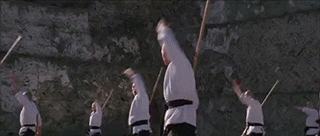

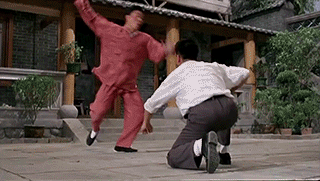
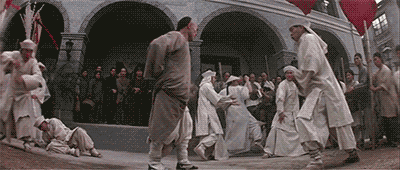


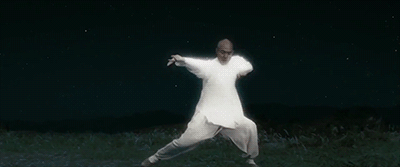
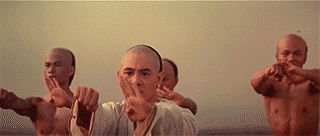
“I realized the Americans wanted me to film for three months but be with the crew for nine. And for six months, they wanted to record and copy all my moves into a digital library.”
“By the end of the recording, the right to these moves would go to them.”
“I was thinking: I’ve been training my entire life. And we martial artists could only grow older. Yet they could own [my moves] as an intellectual property forever. So I said I couldn’t do that.”
- Jet Li on turning down a role for The Matrix
Full article:
https://www.abacusnews.com/digital-life/jet-li-says-he-rejected-matrix-because-he-didnt-want-his-kung-fu-moves-digitally-recorded/article/2169070
284 notes
·
View notes
Text
Review: Drifter TKD (2008)
"Taekwondo is not a corporation! It's an art!"

SOURCE
*SPOILERS AHEAD*
Does anyone else remember Ron Pohnel? He had that awesome ring match against Jean-Claude Van Damme in No Retreat, No Surrender (1986) – the one right before the finale. After that, he practically ceased to exist until IMDb informed us last decade that he was finally working on another movie. And not just any movie, but a full-blown vehicle for himself! I didn’t care that it was going to be a very low-budget effort – I just wanted to see the guy again. However, after waiting almost ten years for a release and then only accessing the film through Pohnel’s Youtube channel, my expectations steadied a little. Little did I know that even then I was in for disappointment. Drifter TKD is a micro action flick burdened by a terrible screenplay and the filmmakers’ failure to take advantage of what resources they have. It’s a poor directorial debut for Pohnel and really just a passion project gone awry.
The story: After giving up his taekwondo school to a greedy corporation, Master Harrison Luke (Pohnel) takes on the life of a destitute drifter. Settling in a homeless community, the master takes a stand for the disenfranchised against a golf club owner trying to intimidate them.
Tempting as it is, I’m not going to compare this to the other movie Pohnel did. However, even judging it on its own merits yields little praise. To be fair, there’s no sense bemoaning its lack of budget and shot-on-video presentation: given his limitations, director/producer/cameraman Ron does well enough. And while the fight scenes are definitely in trouble for being too short most of the time and questionably shot/edited, they reveal that Pohnel is still packing some moves. Nevetheless, the movie does everything else wrong. With the exception of ex-Power Ranger Blake Foster as Harrison’s student, none of the supporting martial stars engage in any of the action – not Mel Novak as the evil CEO, nor Ron Hall as his henchman, nor Leo Fong as Harris’ fellow master. The lighting is off in several scenes and the dialogue isn’t always audible over the soundtrack. The dialogue is weak, frequently sounding contrived and unnatural (“To be a CEO, your heart has to be cold and hard") and with characters repeat their backstories multiple times. Some prominent characters are just outright unlikable, with David Fultz as Harrison’s bumpkin sidekick generating some particular vitriol in my notes.
Worst of all, the story ends up going absolutely nowhere. After almost 90 minutes of testing my patience with poor pacing, the movie resolves none of the problems it’s set up. Harrison remains a drifter, his loyal student returns to his heartless father, the corporation maintains a monopoly on local taekwondo schools, the homeless people remain homeless, and even though the leader of the local gang gets beaten up, both they and the evil club owner are left with no curb on their homeless-harassing and human-trafficking shenanigans. The film kind of addresses this with a last-second philosophy about going with the flow and making the best of a bad situation, but it just feels like a badly-planned story. The characters end up in almost exactly the same place they started, making me feel like I’ve wasted my time.
While I’m criticizing, I might as well also point out the film’s social failings as well, beginning with almost every non-white actor with a speaking role being cast as a villain. Also, at least two female characters are martial artists (Sohara Key and Charl Pohnel) but are also depicted as no match for their male aggressors, making their previous training scenes amount to nothing. One of them gets seriously creeped on by David Fultz’s character with no consequence. Seriously, he’s more harshly reprimanded for incorrectly throwing a kick during martial arts practice, which suggests that even in a movie where sex trafficking is a thing, disappointing your male teacher is a bigger faux pas than threatening women.
As eager as I am to promote indie cinema, it’s hard to recommend this one. It doesn’t take itself very seriously, but the grinding pace and lack of engaging content makes it a chore to sit through. Check it out if you really want to see what’s become of Ron Pohnel, but otherwise just skip to the end of No Retreat, No Surrender again.
THE COPYRIGHT HOLDER HAS MADE THIS TITLE AVAILABLE FOR FREE. YOU CAN FIND IT HERE.

SOURCE
Drifter TKD (2008)
Directed by Ron Pohnel
Written by Ron Pohnel, Charl Pohnel
Starring Ron Pohnel, Blake Foster, Solara Key (Thunderkick), Ron Encarnacion (Parts of the Same Circle)
Cool costars: Martial arts stars Mel Novak (Game of Death), Ron Hall (Bloodsport II), and Leo Fong (Low Blow) are here but don’t fight. Jacob Stiver, Charl Pohnel, and Omar Lizarranga do fight. Longtime TV actor Richard Pines plays the greedy golf club owner.
Content warning: Kidnapping, human trafficking, sexual harassment, homophobic dialogue
Title refers to: “Drifter” refers to the protagonist’s occupation. “TKD” – short for taekwondo – refers to the martial art featured most prominently in the film.
Cover accuracy: A close-up of Ron Pohnel with a wide shot of him (or possibly Blake Foster) walking in the background is appropriate. The billing refers to Charl Pohnel by her full name, Charlene Oka-Pohnel, in contrast to how it appears in the onscreen credits.
Number of full-length fight scenes: 5
Copyright Webgeeks Productions
#film review#film criticism#martial arts#martial arts film#drifter tkd#ron pohnel#blake foster#solara key#ron encarnacion#tae kwon do#taekwondo
3 notes
·
View notes
Text
Review: Circle of Pain (2010)
“Oh my god! What did I do?”

Source
For the longest time I actively avoided MMA-themed action movies, especially the direct-to-video features that began coming out in the 2000s. Overall, I wasn’t wrong to do so, and Circle of Pain is an example why. While rising above the sheer unpleasantness of Never Surrender (2009) – the crown jewel of terrible cage fighting movies – this particular flick is heavily flawed from surface to core and ticks off a lot of personal peeves. Poor writing and bad fight scenes ahead.
The story: An ex-fighter (Tony Schiena) is strong-armed into a high stakes match with a cold-hearted champion (Heath Herring) by a greedy promoter (Bai Ling).
I watched the movie twice in one day, the second time with the commentary track, and this definitely made me appreciate it more. The film was shot in 12 days and the studio meddled with the script, so I’m more forgiving of its more obvious limitations – the small scale and rushed feel. Director Daniel Zirilli shows that he can do a lot with a little, so I’m interested to see what he’d do with more resources and less interference.
…Kinda. Even with regard to its disadvantages, the production doesn’t carry a lot of promise. Foremost, it doesn’t do much with its cast. Aside from the fact that it oversells three of the four stars on its cover (Kimbo Slice, Frank Mir, and Roger Huerta have a combined total of six scenes), the only performer coming out of it relatively well is Heath Herring, who knows how to play an asshole villain. Tony Schiena has some moves and charisma, but he comes across as a blockhead and isn’t particularly likable. Bai Ling will get her own paragraph in a moment. TV’s Louis Herthum is sort of a poor man’s Geoffrey Lewis as the lead’s tough old trainer. And then there’s Dean Cain, playing Schiena’s wheelchair-riding sidekick and no doubt handling the role even better than a genuine disabled actor could… Yeah, right! (It’s not a great role, though: he spends the film living vicariously through the protagonist, and the writers never realize that this isn’t a particularly positive trait.)
The film’s most exploitative feature isn’t violence but sex and nudity. There’s the expected breast shots, and they’re followed up by two or three scenes that are straight up softcore porn. This is strikingly at odds with the rest of the movie’s tone, and for good reason. Zirilli candidly admits that these parts were demanded by producers and that he doesn’t like them, saying that he’d probably prefer the TV version of the film. My biggest gripe on the matter is how it effects Bai Ling, who plays the only substantive female role in the picture. Ling’s part was rewritten from a male role, and the imposed changes seem to mainly be sexing her up ridiculously. (I just can’t see her male counterpart screwing Heath Herring in the gym.) The character’s overt sexuality symbolizes her power, but it’s also meant to demean her, especially when she’s rebuffed. It’s a messy, ungainly dynamic that’s only here because a woman is playing the role. For an infinitely less sexual take on a woman playing a villainous promoter, check out the English language Hong Kong flick Extreme Challenge (2001).
The fight scenes could be better. For some reason, MMA-themed action always looks better in theatrical features than on video, and the same is true here. The fights are kept down-to-earth and realistic out of necessity, but even though they improve throughout the picture, they’re just not very fun. Tony Schiena is a legitimate karate champion, and when he shows off some powerful-looking forms, I couldn’t help but wish he were in a Bloodsport sequel instead of this muddy schlock. The pro fighters do well enough, but having seen Roger Huerta fight in Tekken (2010), I was disappointed that he didn’t get a proper brawl. (He’s Herring’s trainer.)
Again, you can do worse than Circle of Pain in the MMA video genre, but why even go there? It’s bearable if you go in with low expectations and enjoy seat-of-the-pants filmmaking, but c’mon – that’s not what you’re here for. You’re here to watch your favorite pro fighters headline a killer action movie, and that’s just not what happens. Leave it be.

Source
Circle of Pain (2010)
Directed by Daniel Zirilli (Crossing Point)
Written by Bobby Mort (Scorched Earth), Daniel Zirilli (story), Sean Patrick O’Reilly (story)
Starring Tony Schiena (Locked Down), Bai Ling (Game of Assassins), Dean Cain (Lois & Clark: The New Adventures of Superman), Heath Herring (Chavez: Cage of Glory)
Cool costars: Louis Herthum (Westworld) as the trainer. The list of supporting fighters include Kimbo Slice (Blood and Bone), Frank Mir (Hell’s Chain), Roger Huerta (Tekken), Yves Edwards (Beatdown), Miguel Torres, Conner Brantley, and Carlo Prater.
Content warning: Sexual harassment, sexist & ableist dialogue, violence against the disabled
Title refers to: Literally, the caged ring which the fighters compete it…even though it’s not actually circular. Figuratively, it may refer to the destructive cycle of doubt and guilt that the protagonist deals with after paralyzing his best friend.
Cover accuracy: Slice, Mir, Huerta, and Herring certainly do appear in the movie, but their billing and promotion come at the expense of the actual leads. Also putting Slice ahead of Herring – both in billing and in placement – is a hard faux pas. The Tapout logo is better-placed, though, as it’s featured very prominently throughout.
Copyright Grindstone Entertainment Group / Lionsgate Home Entertainment
#film review#film criticism#action film#martial arts#martial arts film#circle of pain#mma#mixed martial arts#tony schiena#bai ling#dean cain#heath herring
4 notes
·
View notes
Text
All-Female Warriors
The Kyoshi Warriors - Avatar: The Last Airbender (2005-2008)
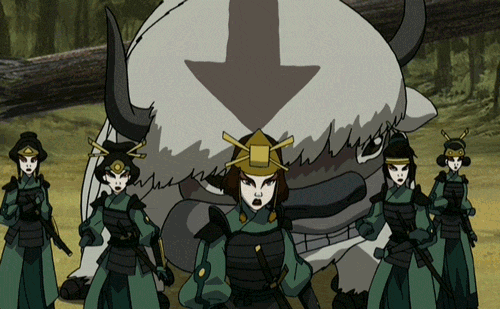
The Vuvalini - Mad Max Fury Road (2015)

The Amazons - Wonder Woman (2017)

The Valkyries - Thor: Ragnarok (2017)
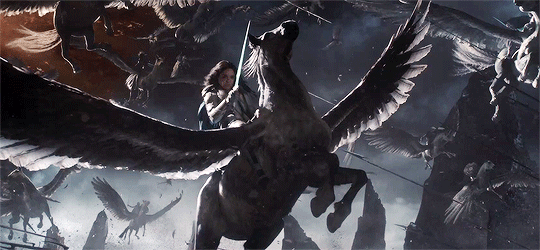
The Dora Milaje - Black Panther (2018)

31K notes
·
View notes
Video
here it is, the only important video on the internet
15K notes
·
View notes
Text
if movies about men got reviewed the same way movies about women did
“Look. Don’t get me wrong: no one is happier than me to see a man finally starring in a lead role in an action movie (especially when they look as tantalizing in a tank top as Mr. Willis.) but at the end of the day, the hard truth about Die Hard is this: it’s mediocre. The script is bland, the pacing is excruciating, and although it has a few decent lines, it’s trying way, way too hard to be funny and only succeeding half the time. The focus on “male empowerment” is way too overt and comes across as ham-fisted, like the movie is trying to beat the audience over the head with “SEE? MEN CAN LEAD ACTION MOVIES, TOO!” without seeming to have anything more nuanced to say about the matter. Ultimately, Bruce Willis climbing around a building and beating up terrorists for two hours isn’t quite interesting enough to hold this reviewer’s attention. If you can shut off your brain and pretend not to notice the glaringly obvious plot holes riddled through this corporate-engineered script, then Die Hard may be the film for you. If not, however, you’ll probably be better off rewatching Ocean’s 8 instead.”
75K notes
·
View notes
Photo
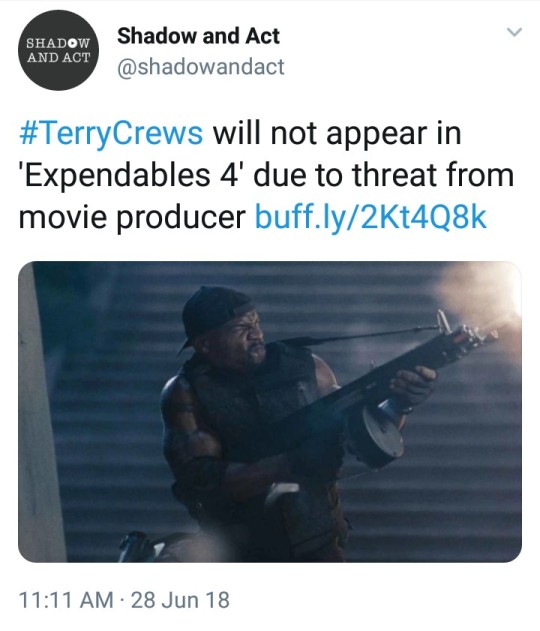
Terry Crews came out and admitted he had been sexually assulted by someone in the film industry, and is now being blacklisted. I have been a fan of his since Idiocracy, and will continue to support all of his work.
So when you wonder why people don’t come forward with their assults, this is why.
190K notes
·
View notes
Text
people of color: we’re excited to see remakes of shows that have characters that look like us. it makes us feel represented and that’s great.
the whites who have 200+ shows with characters that look like them:

46K notes
·
View notes